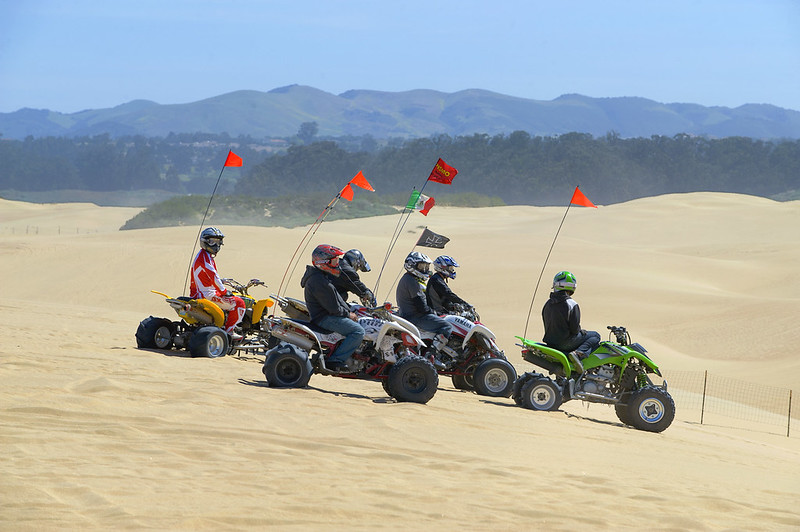Opinion: Vehicles on the beach don’t pay for Oceano

By Nick Alter
For nearly 40 years the California Department of Parks and Recreation has been operating the Oceano Dunes State Vehicular Recreation Area, as permitted by the California Coastal Commission in 1982. As permitted, street-legal vehicles have been allowed to drive up and down a two-mile stretch of beach extending from Grand Avenue in Grover Beach, across Oceano’s beachfront and the Arroyo Grande Creek, to a staging area a mile south of Pier Avenue in Oceano, where ATVs and other off-highway vehicles—known commonly as “OHV”— can then be driven in designated areas in the dunes.
Next to public health and safety, the chief concern for beach communities like Oceano, Grover Beach and Pismo Beach is the impact OHV activity has on business volume and the local economy. Community beachfronts are their most valuable economic asset for generating revenue growth and creating jobs. This is especially the case for a distressed community like Oceano, where OHV activity extends across the full length of its beachfront, effectively obstructing pedestrian use, visitor-serving business activity and prospects for economic growth.
Pismo Beach’s beachfront is entirely vehicle-free, although it wasn’t always this way. Its economy once languished while the city allowed cars on its beach a few decades ago. This changed when the city banned vehicles on its beach in the 1980s, leading to the booming local economy Pismo has enjoyed ever since.
As a low-income community with a predominantly Latino population and a high jobless rate, Oceano was designated a disadvantaged community and Opportunity Zone by then-Gov. Jerry Brown in April 2018. This designation sparked community interest in exploring with graduate students in Cal Poly San Luis Obispo’s City and Regional Planning Department what might be possible as an economic growth path.
In two successive “planning studios” in the 2018-19 academic year the Cal Poly graduate students helped residents map out alternative futures for Oceano.
In the first of these, CRP students met with residents in Oceano for a series of four workshops, leading them progressively through a process that culminated in the preparation of a community plan update in March 2019.
The second workshop picked up where the first left off, with a series of projects that included specific plans for the conceptual modeling of Pier Avenue as a visitor-serving business district, and of an Oceano Town Center in an adjoining area with a mix of commercial, residential, educational, and cultural/historical land uses.
The 65-acre Town Center plan was recently mapped with 30 acres of open space and trails, 12 types of residential housing, more than 350,000 square feet of commercial space, 200,000 square feet of hospitality and community facilities, 350,000 square feet of education and historic facilities, and 150,000 square feet of parking.
The resultant land-use map and underlying construction details are now being used by Cal Poly Professor Pratish Patel and his finance students for the preparation of a pro forma financial analysis of projected business revenue, tax revenues, county leasing revenue, costs and capital requirements, operating expenses, asset valuation, financial returns where applicable, and jobs.
When this is done, it will then be possible to design and implement a community-wide study with Oceano residents, asking them about the kind of redevelopment they’d like to see in Oceano, while showing them what might be possible in terms of job creation, housing and improved living conditions.
The sole purpose of the Town Center design modeling and economic modeling is to show possibilities for redevelopment, not to promote any particular model or even the idea for this kind of redevelopment.
The basic question being addressed is whether and to what extent the asset value of Oceano’s beachfront and the resultant socioeconomic returns on this asset (to Oceano residents, businesses, and the county) are greater with or without recreational vehicle activity on Oceano’s beachfront.
We already know that communities with vehicle-free beachfronts in the county are thriving, while Oceano is not—and will not, if cars and trucks continue to drive on its beachfront.
We also know that State Parks’ 2017 claim of a $243 million positive economic impact is spurious, a claim that Patel refuted in a widely circulated 2018 critique, and further debunked in his just-published report, “Economic Impact from Suspension of the Vehicular Use at the Oceano Dunes SVRA.”
So, we have three evidentiary sources telling us two things: that OHV activity at Pismo State Beach and Oceano Dunes has had no significant economic impact; and, that OHV activity on beachfronts can obstruct or inhibit a community’s economic growth.
What remains to find out is:
• How much of an economic opportunity there might be for Oceano and the county by redeveloping Oceano as a beach community, versus the non-beach community it has become since 1982 when its beachfront was repurposed for recreational driving; and
• What area residents prefer versus what governing authorities, special interests and outsiders prefer.
The economic choice seems clear enough to warrant consideration for further investigation by and for the county.
• Nick Alter is a retired executive and co-founder of the Ocean Economic Development Council.









